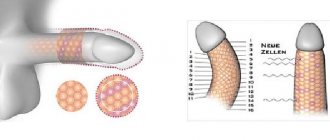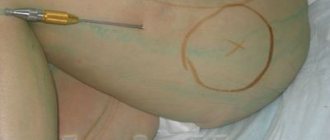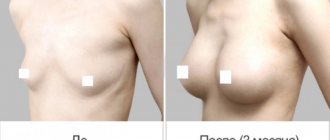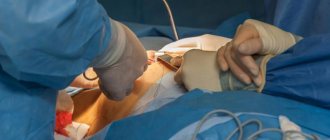Reduction mammoplasty is a reduction in breast size through surgery. This procedure is carried out only when prescribed by a doctor, it allows you to remove excess stress on the spine, get rid of skin rash, and also return the breasts to a girlish shape.
Excessively large breasts sometimes bring more problems to their owners than joy. Too large a bust size can cause the development of pathologies in a woman’s body, which is why reduction mammoplasty is prescribed.
A high-quality operation does not leave scars or stretch marks; it gives a woman’s bust a beautiful and neat outline.
What is reduction mammoplasty
Reduction mammoplasty is a surgical operation that allows you to reduce the size and shape of a woman’s breasts. This procedure is aimed at combating pathology such as gigantomastia - excessive enlargement of the mammary gland.
As a rule, this disease develops in adulthood, after childbirth, during obesity or endocrine failure. There are also cases of gigantomastia occurring in young girls, however, no general explanation has yet been found for this phenomenon - the mechanism of development of this disease is complex and has not been fully studied.
Reduction mammoplasty and mastopexy are two different processes. The last procedure refers to aesthetic surgery. Both operations are aimed at breast reduction, but are performed using different technologies and have different indications.
Types of breast hypertrophy
Conventionally, several types of hypertrophy are distinguished:
- by origin: obesity, endocrine disruption, pregnancy;
- by structure: increase in glandular or adipose tissue;
- by localization: on one or both sides;
- with or without breast ptosis (loss of breast firmness);
- by severity: I, II, III, IV.
Reduction mammoplasty for gigantomastia is an effective, albeit radical, method to solve the problem with bust size. Before prescribing an operation, the doctor must collect all the information and prescribe a procedure that will help in the current case.
Each woman’s body has an individual structure and it is strictly prohibited to prescribe surgery based on a simple external examination.
When choosing a surgeon and a clinic, you should pay attention to how the doctors treat the patient’s case. The more details they collect, and the more they delve into the problem, the greater the chance that the operation will be successful and without complications.
Indications and contraindications for mammoplasty
The operation can be performed only if there is a doctor's testimony.
INDICATIONS
- excessive enlargement of the mammary gland, causing discomfort to the patient;
- the presence of headaches and a feeling of heaviness in the back, discomfort in the neck and shoulders;
- acquired scoliosis, curvature of the spine, problems with posture;
- the presence of diaper rash and irritation on the skin under the breasts;
- sagging of the bust, loss of aesthetic beauty.
CONTRAINDICATIONS
- pregnancy or lactation period;
- infectious, bacterial and oncological diseases;
- problems with blood clotting;
- serious hormonal imbalances;
- diabetes;
- thyroid diseases;
- presence of cyst(s) in the bust area;
- serious diseases of other organs or the circulatory system.
The operation should not be performed on young girls under 18, or on women planning a pregnancy in the near future.
The surgeon must conduct a thorough examination before scheduling surgery. It is necessary to determine the individual reactions of the body to the administration of the drugs used.
Operation planning, preparation
Planning the operation must necessarily include:
- general clinical and laboratory examination;
- consultation with an oncologist-mammologist;
- assessment of the ratio of mammary gland and fatty tissue;
- study of body proportions, as well as the presence of stretch marks.
Before the operation, a consultation will be scheduled with the surgeon, who must listen and take into account the patient’s wishes.
Reduction mammoplasty for gigantomastia will help get rid of unpleasant sensations, excessive load on the spine and return life to its former comfort.
The doctor must study the full clinical picture, explain to the patient how the operation will proceed, and the features of breast physiology in the current case. During the examination, it becomes necessary to conduct an electrocardiogram and ultrasound of the breast.
If a woman plans to lose weight in the future, then surgery should be scheduled only after the patient achieves the desired result. If surgery is performed before total body weight is reduced, the breasts will eventually lose their aesthetic appearance.
For this reason, mammoplasty is prescribed last. It is also necessary to purchase a special medical fixing bra that will provide breast support after surgery.
Reduction mammoplasty does not affect the process of lactation in the future. And there is no data on the provocation of breast cancer after reduction mammoplasty.
How many years does the result last?
The result after mammoplasty of the 3rd category of complexity depends on the characteristics of the body. Many experts claim that the effect lasts for life.
Repeated surgery may be required if, as a result of hormonal changes, the size of the breast increases, or surgical intervention is required for other reasons in the area of the mammary gland. Removal and re-implantation of implants is required when losing weight, when a person loses more than 10% of body weight.
Reduction mammoplasty: what is it and how does it proceed?
Operation methods
The method of operation directly depends on the patient's condition. The doctor must individually determine the degree of sagging of the mammary gland and prescribe surgery. In each individual case, it can proceed in the following way:
- micro-incisions – used in cases where the breasts do not sag, but need to remove excess fat. Liposuction is performed through a small incision using a catheter;
- periareolar incision - along the edge of the areola;
- “keyhole” incision - made along the contour of the nipple and lowered;
- “anchor” incision - a T-shaped incision that follows the contour of the areola, after which it descends in a vertical position to the inframammary fold and continues along the latter. The most common method at the moment.
The method should be selected based on the individual characteristics of the patient’s body, as well as on the basis of the current clinical picture.
How does the operation proceed?
Conventionally, the operation can be divided into stages. First, excess in the lateral and lower areas of the breast is removed, which allows you to give the desired shape without obvious signs of surgical intervention.
Incisions made along the contour of the areola, as well as the one directed vertically downwards towards the fold, allow you to give the breast a beautiful shape and reduce its size (up to 5 units). No more than 1 kg of adipose tissue and glands can be removed in one operation.
The choice of places for making incisions is chosen so that even during the period of resorption they are invisible.
Kinds
Reduction mammoplasty can be performed in two ways, which differ in the types of incisions:
- Vertical - around the areola and vertically to the fold under the breast. This method is the least traumatic, but is only suitable for a small amount of work.
- Anchor or T-shaped - in addition to the vertical incision, an incision is made in the inframammary fold (under the breast). This method is necessary when the gland is greatly reduced (from 500 grams). The seam in this case will be more noticeable.
Promotion
Question answer
Breast reduction is a surgical procedure that comes with risks. Side effects may include infection, bleeding, bruising, wound healing problems, and abnormal scarring. In addition, surgery may also negatively affect your ability to breastfeed. There is a risk of loss or reduction of nipple sensitivity.
This is a common question. The answer is: no, in most cases the nipples are not removed during surgery.
Unfortunately, the bust may increase in size after such surgery. This can be affected by weight gain, pregnancy and menopause.
Complications
Immediately after the procedure, the following side effects cannot be ruled out.
Swelling
It is considered normal and appears against the background of soft tissue injury. A cause for concern is the persistence of symptoms for 2 weeks or more.
Hematomas
The appearance of a defect is indicated by a lump or lump formed under the skin. To eliminate the problem, blood clots are cleared out through the incision.
Itching and suppuration
These are signs of the development of inflammation, which is caused by the penetration of pathogenic bacteria into the wound surface. Symptoms are accompanied by fever, pain in the back, and prolonged healing of the nipples.
Seroma
A characteristic liquid begins to accumulate under the implant. At the same time, the mammary glands increase significantly in volume. To identify pathology, an ultrasound examination is performed, and the exudate is pumped out using a syringe.
Other early consequences include:
- shooting pains in the nipple area;
- asymmetrical breast location;
- manifestation of an allergic reaction to the material used;
- decreased elasticity ;
- lack of sensitivity in the operated area.
Late complications include implant rupture, contouring, displacement, cracking, necrosis, and calcification.
Reduction mammoplasty: rehabilitation after surgery
After mammoplasty, as after any other operation, it is necessary to adhere to certain rules and restrictions. You should use special underwear and follow certain instructions.
During the entire rehabilitation period (from 30 to 50 days), it is prohibited to visit:
- baths;
- saunas;
- jacuzzi;
- swimming pools;
- massage showers.
You should also pay close attention to the following recommendations:
- if you observe enlargement of the mammary glands (swelling of the breasts), as well as in the presence of constant pain, you should visit a doctor;
- the first few days are spent under the close supervision of doctors, the length of hospitalization directly depends on the severity of the operation; in case of physical damage and impacts (including accidental ones), you must make an appointment with a doctor;
- Smoking and drinking alcohol are strictly prohibited; any vasodilating drugs must be excluded;
- it is necessary to follow a diet that excludes salty and spicy foods; drinking water is allowed in small quantities;
- you should abstain from sexual activity;
- Showering is allowed only on the 5th day after surgery, under low pressure, the water temperature should not exceed 38-39 degrees. You should simply pour water over your breasts, but under no circumstances rub them or use regular detergents.
If the above rules are followed, as well as with a sufficient amount of rest and relaxation, the rehabilitation period can be almost painless.
If you observe any sensations that cause discomfort, you must contact your doctor for an examination and ask him all your questions.
Reviews of women who have undergone reduction mammoplasty
Reduction mammoplasty, reviews of which are easy to find on the Internet, has more supporters than opponents. You can often hear that a decrease in breast size, as well as an increase in breast size, is an unnatural process that negatively affects women’s health. But that's not true.
During breast augmentation, so-called implants are used - foreign bodies that perform an aesthetic function.
Reduction mammoplasty is a process that is necessary to carry out when pathologies occur in the form of curvature of the spine and the formation of scoliosis. With a high-quality operation, breastfeeding is also possible.
Let's read what women who have undergone mammoplasty say:
IRENE, 54 YEARS OLD, SOCHI:
“I have suffered from large breasts all my life.
And at school I was teased, and I was ashamed to walk with my shoulders proudly straightened, and I slouched all my life. After the birth of her first daughter, her breasts increased two sizes and began to sag. Soon a second daughter was born; her breasts did not increase in size, but sagged even more. And about 3-4 years ago I began to suffer from severe back pain. Between the shoulder blades.
Doctors said that mammoplasty should be done, but my husband was against it. He said that large breasts are a woman’s dignity, that I would ruin my appearance if I agreed to the operation. But scoliosis decided everything for me.
I was already ready to sacrifice my appearance just to get rid of these wild pains. It’s impossible to sleep on your chest; choosing underwear in general is a whole story. In general, I decided.
My only regret is that I didn't have the surgery sooner. Firstly, my breasts looked like they did in my youth. She has not shrunk, but she has become more beautiful. My husband gasped and said that now he likes me even more.
Secondly, after a (quite long) rehabilitation, I was able to sleep peacefully on my stomach. I choose the underwear I want, and most importantly, the pain has gone away. I actually had to work with a therapist, but the spine was cured.
I was very happy. We paid about 300,000 thousand rubles (in 2016), but for a standard operation. For gigantomastia they make it more expensive, and I don’t remember exactly how much. But I recommend it to everyone. I myself was very pleased, I felt about 15 years younger.”
MARINA, 45 YEARS OLD, ARKHANGELSK:
“I, like many others, suffered from back pain.
I am raising a 15-year-old girl and don’t plan to have any more children. I don’t know if I would have decided to have the operation if I was younger, but now there was nothing holding me back. I underwent reduction mammoplasty, 1st degree reduction. I don’t remember the operation itself, it was done under general anesthesia, but I was tormented by pain during the recovery process for about a month. I had a hard time, and at that moment I really regretted that I agreed.
And then, when everything passed and I fully recovered, I began to look at the situation differently - my breasts were beautiful, my back pain was cured, my life became more comfortable. Now that it's all over, I'm happy.
But, you need to be prepared for the fact that it is not the operation itself that is painful, but the recovery period. If I had been warned then, I don’t know whether I would have agreed or not.”
Expert opinion
- Cosmetologist
- Surgeon
Irina Dorofeeva
practicing cosmetologist
Breast reduction can help reduce pain in the back, shoulders, neck and head. It is recommended to think about surgery if your bust is too large, there is noticeable asymmetry, irritation constantly appears on the skin under the mammary glands, you cannot play sports normally due to your large size, or you develop complexes.
Michelle Place
plastic surgeon
Breast reduction is performed at different ages, but plastic surgeons usually advise waiting until breast development stops after puberty.
Consider consulting with at least three different doctors. During your consultation, expect the doctor to ask you what bust size you want. Breast reduction surgery usually takes two to three hours. You will be put under general anesthesia. Your surgeon will likely make three different incisions on one breast to remove excess tissue, fat, and skin. You can hear the expert's opinion by watching the following video:
Reduction mammoplasty is aimed at restoring a feeling of lightness and comfort to the female body. If scoliosis or atherosclerosis develops in the cervical spine, due to excessive stress due to large breasts, it is necessary to carry out this procedure, since this problem can worsen with age.
Is there a danger for nulliparous women?
During pregnancy, from conception to childbirth, a woman's breasts undergo a number of changes. Many patients are interested in whether there is a danger of mammoplasty for nulliparous women, and what consequences they expect in the future.
The procedure can be performed on girls who do not have children. But it is recommended to plan conception after surgery at least a year later. The body needs this period for complete recovery. In addition, only after 10-12 months can you be completely sure that there are no long-term complications.
After giving birth and breastfeeding, the mammary glands do not always change their shape so much that replacement of implants is required. But in any case, you should definitely consult a doctor, since each body is individual.
Mammoplasty is not dangerous for nulliparous women. If the breasts have changed significantly, you need to consult a doctor and replace the implants.











